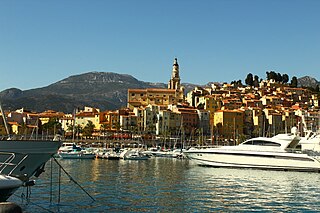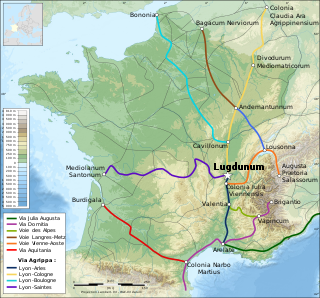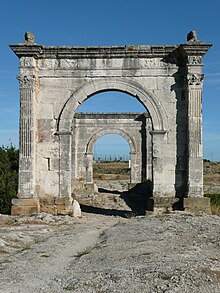Favorinus was a Roman sophist and skeptic philosopher who flourished during the reign of Hadrian and the Second Sophistic.
Following is a list of rivers of classical antiquity stating the Latin name, the equivalent English name, and also, in some cases, Greek and local name. The scope is intended to include, at least, rivers named and known widely in the Roman empire. This includes some rivers beyond the bounds of the Roman empire at its peak.

Menton is a commune in the Alpes-Maritimes department in the Provence-Alpes-Côte d'Azur region on the French Riviera, close to the Italian border.

The Via Aquitania was a Roman road created in 118 BC in the Roman province of Gaul. It started at Narbonne, where it connected to the Via Domitia. It then went toward the Atlantic Ocean, via Toulouse and Bordeaux, covering approximately 400 kilometres (250 mi).

The Via Aurelia is a Roman road in Italy constructed in approximately 241 BC. The project was undertaken by Gaius Aurelius Cotta, who at that time was censor. Cotta had a history of building roads for Rome, as he had overseen the construction of a military road in Sicily connecting Agrigentum and Panormus.

The Aquitani were a tribe that lived in the region between the Pyrenees, the Atlantic ocean, and the Garonne, in present-day southwestern France in the 1st century BCE. The Romans dubbed this region Gallia Aquitania. Classical authors such as Julius Caesar and Strabo clearly distinguish the Aquitani from the other peoples of Gaul, and note their similarity to others in the Iberian Peninsula.

Travels Through France and Italy is travel literature by Tobias Smollett published in 1766.

The Via Postumia was an ancient Roman road of northern Italy constructed in 148 BC by the consul Spurius Postumius Albinus Magnus. It ran from the coast at Genua through the mountains to Dertona, Placentia and Cremona, just east of the point where it crossed the Po River. From Cremona the road ran eastward to Bedriacum, the current town of Calvatone, where it forked, one branch running to the right to Mantua, the other to the left to Verona, crossing the Adige river on the Ponte Pietra, the only bridge on the Adige river at that time, and then traversing the Venetian plain, crossing the Piave River at Maserada sul Piave until finally reaching Aquileia, an important military frontier town founded by Rome in 181 BC. The Roman conquest of Liguria depended upon this road, and several of the more important towns owed their origin largely to it. Cremona was its central point, the distance being reckoned from it both eastwards and westwards.

Ceva, the ancient Ceba, is a small Italian town in the province of Cuneo, region of Piedmont, 49 kilometres (30 mi) east of Cuneo. It lies on the right bank of the Tanaro on a wedge of land between that river and the Cevetta stream.

Publia Fulvia Plautilla was the wife of the Roman emperor Caracalla, her paternal second cousin. After her father was condemned for treason, she was exiled and eventually killed, possibly on Caracalla's orders.
The Marici were a Celto-Ligurian tribe dwelling around present-day Pavia (Lombardy) during the Iron Age.
Publius Septimius Geta was the father of the emperor Lucius Septimius Severus, father-in-law of the Roman empress Julia Domna and the paternal grandfather of the Roman emperors Caracalla and Geta. Besides mentions in the Historia Augusta, Geta is known from several inscriptions, two of which were found in Leptis Magna, Africa.

The Pont Flavien is a Roman bridge across the River Touloubre in Saint-Chamas, Bouches-du-Rhône department, southern France. The single-arch crossing, which was built from limestone, was on a Roman road - the Via Julia Augusta - between Placentia, Italy and Arles. It is the only surviving example of a Roman bridge bounded by triumphal arches from the Augustan period, although similar bridges probably existed elsewhere, as indicated by portrayals on coins of the late 1st century BC.
Gaius Avidius Nigrinus was a Roman senator who lived between the 1st and 2nd centuries. Nigrinus served as suffect consul for the nundinium of April to June 110 with Tiberius Julius Aquila Polemaeanus as his colleague.

Avidia was a well-connected noble Roman woman. She is among the lesser known members of the ruling Nerva–Antonine dynasty of the Roman Empire.
The Temple of Juno Lucina was a Roman temple dedicated to Juno Lucina on the Esquiline Hill in Rome. It was dedicated on 1 March 375 BC, the festival of the Matronalia. Before its construction, the cult of Juno Lucina occurred in a sacred grove or lucus on the site - Varro dates the cult's origin to Titus Tatius, king of the Sabines. It was struck by lightning in 190 BC, damaging the tympanum and doorway. In 41 BC the quaestor Quintus Pedius built or rebuilt a wall possibly dating back to the sacred grove. It was still operational in the imperial period, as attested to in inscriptions.
The Temple of Fortuna Respiciens was a temple in ancient Rome, sited on the western slopes of the Palatine Hill. It is mentioned in the 4th century Regional Catalogues. The only surviving part of its structure is a polychrome pediment discovered on via di San Gregorio in the Neronian fire layer and now in the Capitoline Museums

The Porta Aurelia-Sancti Petri was one of the gates of the Aurelian walls in Rome (Italy). It was originally called the Porta Cornelia.

The Temple of Jupiter Apenninus or Temple of Jupiter Poeninus was an Umbrian-Roman temple that lay at the foot of Monte Catria, near the modern village of Scheggia, between today's Umbria and Marche regions, in Italy. The temple stood near the ancient Via Flaminia, 200 km from Rome, where the road crossed the Apennines. The structure, once one of the most important Umbrian shrines, has now completely disappeared.












